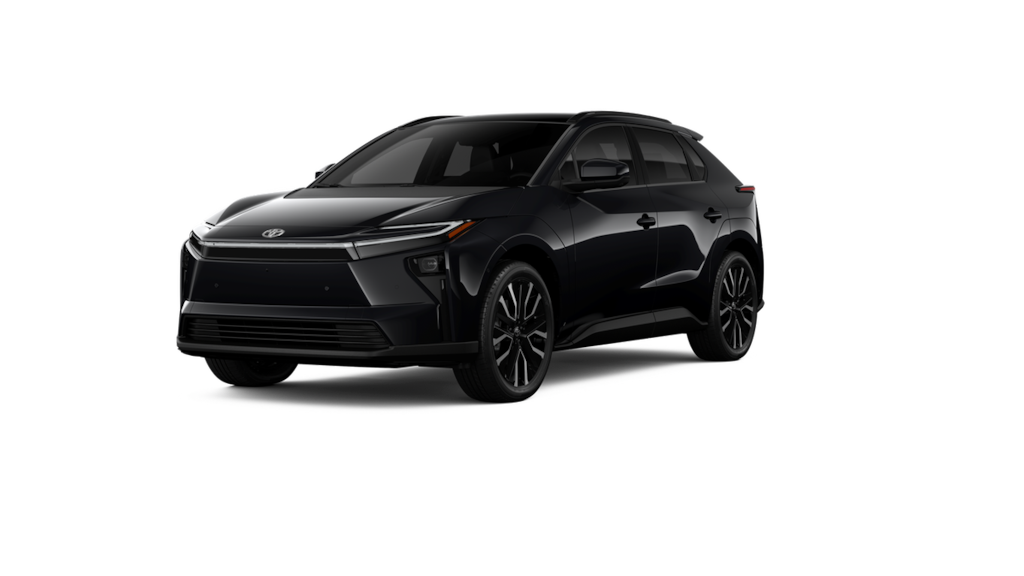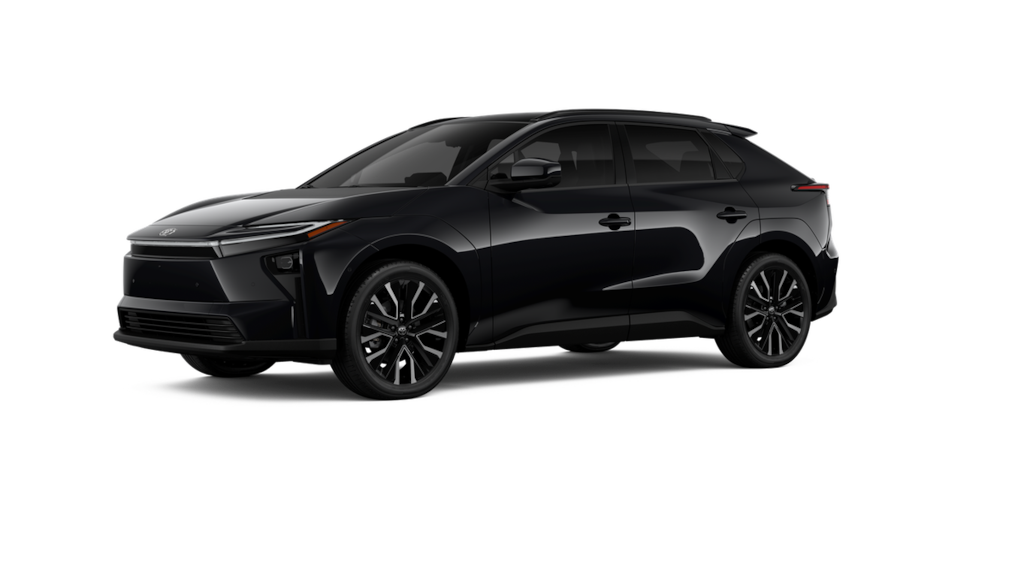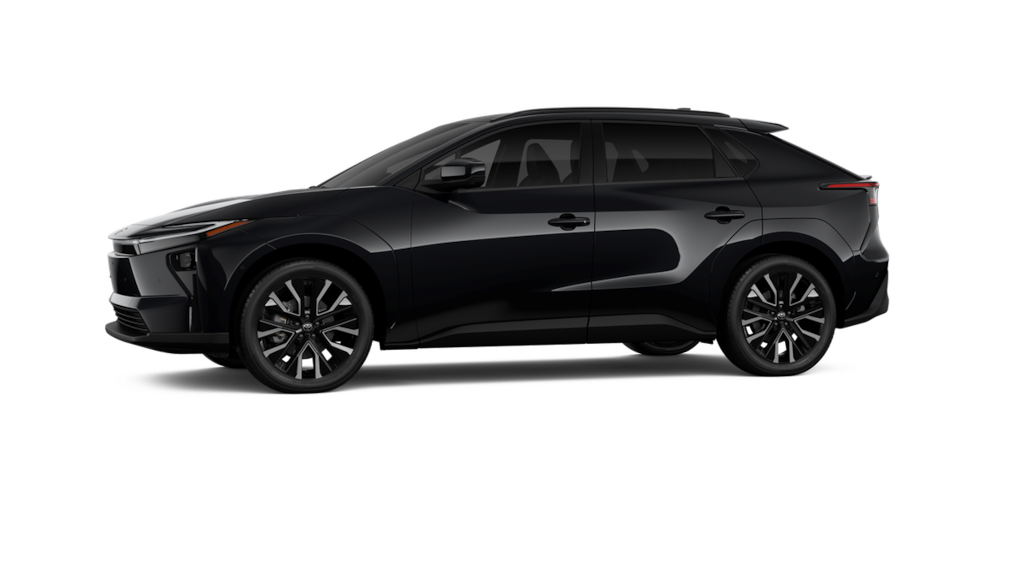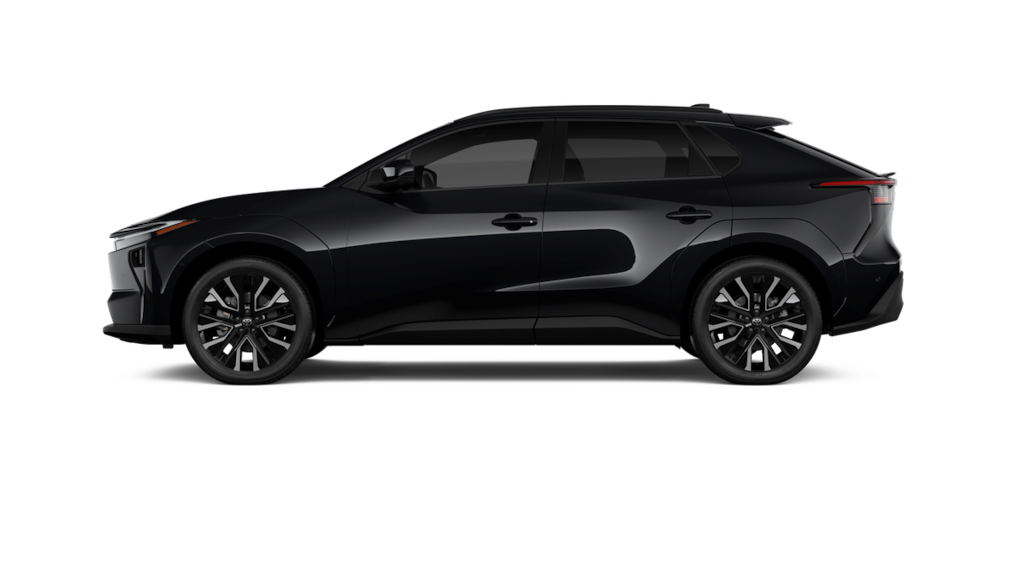New 2026 ToyotaBZ Limited
- Exterior Color
- Midnight Black Metallic
- Interior Color
- Black SofTex
- Transmission
- 1-Speed Automatic Transmission
- Drivetrain
- All-Wheel Drive
- VIN
- JTMBDAFB2TA000446
- Stock Number
- K5674
Toyota
BZ
Included Packages & Accessories
- Door edge guards.
- 9-speaker jbl® premium audio.
- 50 state emissions.
- Illuminated door sills.
- Mudguards.
- Alloy wheel locks.
Included Packages & Options
More manufacturer pre-installed items
$1,410 total, included in TSRP
- Door edge guards.$165Help prevent door edge dings and chipped paint with this protective finishing touch. Thermoplastic-coated stainless steel is precisely matched to the exterior paint. Compression-fitted to door edge contours.
- 9-speaker jbl® premium audio.$5809-speaker jbl® premium audio including subwoofer and amplifier. Disclaimer: Jbl® is a registered trademark of harman international industries, inc.
- Illuminated door sills.$395Led logo illuminates icy white when the front doors are open to help with entry into the bz. Durable corrosion resistant finish features polished accents.
- Mudguards.$165Help protect your paint finish from road debris and the damage it causes. Designed to integrate with exterior styling. Set includes four mudguards.
Detailed Specifications
- 20-in. Black multi-spoke alloy wheels.
- Black window trim.
- Color-keyed outside door handles with touch-sensor lock/unlock feature on all doors.
- Ducktail rear spoiler.
- Heated power outside mirrors with turn signal and blind spot warning indicators,puddle lights, memory settings, and power-folding and reverse tilt-down features.Do not rely exclusively on blind spot monitor. Look over shoulder and use turn signal. See. Owner's. Manual. For limitations.
- Height-adjustable, foot-activated power liftgatewith jam protection.Water, weather, dirt, and other conditions may cause the hands-free power liftgate sensor to not operate properly. See. Owner’s. Manual. For limitations.
- Led daytime running lights (drl).
- Led projector low- and high-beam headlights, automatic high beams (ahb),and auto on/off.Automatic high beams operate at speeds above 21 mph. See. Owner’s manual. For instructions and limitations.
- Led taillights and stop lights.
- North american charging system charging port.
- Panoramic fixed-glass moonroof with power sunshade.
- Privacy glass on all rear side, quarter and liftgate windows.
- Rain-sensing variable intermittent windshield wipers with de-icer function.
- Rear lower diffuser.
- Roof-mounted shark-fin antenna.
- Split roof rear spoiler.
- Unique color-keyed center bumper; thin lower grille.
- Unique hammerhead hood with black-painted accent.
- 120v/1500w ac outlet.
- 14-in. Toyota audio multimedia with six speakers, wireless apple carplay®& android auto™compatibility, siriusxm® 3-month trial subscription.See toyota.Com/connected-services for details.Apple carplay® requires a compatible iphone® with an active data plan. Check compatibility at. Https://www.Apple.Com/ios/carplay/. . Operability depends on network availability, a cellular connection and gps signal. Services vary by vehicle and are subject to change at any time without notice. Data charges may apply. To learn more, go to. Https://www.Toyota.Com/audio-multimedia/. . To learn more about toyota connected services data collection, use, sharing and retention practices, please visit. Https://www.Toyota.Com/support/privacy-notice/. . Apple carplay® is a registered trademark of apple inc.,Wireless use of android auto requires a compatible android 11.0+ phone and compatible active data plan. Check. G.Co/androidauto/requirements. For compatibility. Operability depends on network availability, a cellular connection, and gps signal. Services vary by vehicle and are subject to change at any time without notice. Data charges may apply. To learn more, go to. Https://www.Toyota.Com/audio-multimedia/. . To learn more about toyota's connected services data collection, use, sharing, and retention practices, please visit. Https://www.Toyota.Com/support/privacy-notice/. . Google, android, android auto, youtube music and other marks are trademarks of google llc.,Service will automatically stop at the end of your trial subscription period unless you decide to continue service. Trial is non-transferable. If you do not wish to enjoy your trial, you can cancel by calling the number below. All siriusxm services require a subscription, each sold separately by siriusxm after the trial period. Service subject to the siriusxm customer agreement and privacy policy, visit siriusxm.Com for complete terms and how to cancel which includes online methods or calling 1-866-635-2349. Some services and features are subject to device capabilities and location availability. Satellite service not available in ak & hi. Content varies by siriusxm subscription plan. All fees, content and features are subject to change. Siriusxm and related logos are trademarks of sirius xm radio inc. And its respective subsidiaries.
- 60/40 split, reclining fold-flat rear seats with center armrest and cup holders.
- Black carpet flooring with driver-side footrest.
- Black interior door handles.
- Cargo area tonneau cover.
- Center console with covered storage compartment, two cup holders, two qi-compatible wireless chargersand front lower storage tray.Wireless charging may not be compatible with all mobile phones, smart devices, tablets, e-readers, mp3/wma players and like products.
- Dial-type shift knob.
- Digital keycapability — digital keyenables smartphone to be used instead of a physical key (remote connectsubscription required).Digital key requires active remote connect subscription. Remote start/stop and/or lock/unlock and other features of remote connect are only available on select models. Use only if aware of circumstances surrounding the vehicle it is legal and safe to do so (e.G., do not remotely start a gas engine vehicle in an enclosed space or if the vehicle is occupied by a child). Remote connect depends on certain factors outside of toyota's control in order to operate, including 4g network availability, a cellular connection, and gps signal. Without any one or more of these things, operability may be limited or precluded. Digital key also requires. Bluetooth. ® connectivity. Remote connect is included with select paid connected services packages. See your toyota dealer for details. Services may vary and are subject to change without notice. Services require account registration through the toyota app and acceptance of the connected services terms of use at. Https://www.Toyota.Com/content/dam/toyota/privacyvts/pdf/connected-services-terms-use.Pdf. And master data consent. Data charges may apply. For toyota connected services’ vehicle-generated data collection, use, sharing, and retention practices and agreements, see. Https://www.Toyota.Com/support/privacy-notice/. .,Digital key requires active remote connect subscription. Remote start/stop and/or lock/unlock and other features of remote connect are only available on select models. Use only if aware of circumstances surrounding the vehicle it is legal and safe to do so (e.G., do not remotely start a gas engine vehicle in an enclosed space or if the vehicle is occupied by a child). Remote connect depends on certain factors outside of toyota's control in order to operate, including 4g network availability, a cellular connection, and gps signal. Without any one or more of these things, operability may be limited or precluded. Digital key also requires. Bluetooth. ® connectivity. Remote connect is included with select paid connected services packages. See your toyota dealer for details. Services may vary and are subject to change without notice. Services require account registration through the toyota app and acceptance of the connected services terms of use at. Https://www.Toyota.Com/content/dam/toyota/privacyvts/pdf/connected-services-terms-use.Pdf. And master data consent. Data charges may apply. For toyota connected services’ vehicle-generated data collection, use, sharing, and retention practices and agreements, see. Https://www.Toyota.Com/support/privacy-notice/. .,Use only if aware of circumstances surrounding vehicle it is legal safe to do so (e.G., do not remotely start a gas engine vehicle in an enclosed space or if vehicle is occupied by a child). Remote connect services vary by vehicle and are subject to change at any time without notice. Services depend on 4g network availability, a cellular connection and gps signal. Without any one or more of these things, operability may be limited or precluded. Further, if and when 4g network changes or is discontinued, or the underlying technology required to support service becomes obsolete, then the services will not work and will need to be discontinued. Digital key also requires. Bluetooth®. Connectivity. Not available on manual transmissions. Services require account registration through toyota app and acceptance of connected services terms of use at. Toyota.Com/content/dam/toyota/privacyvts/pdf/connected-services-terms-use.Pdf. And master data consent. Data charges may apply. For toyota’s connected services’ vehicle-generated data collection, use, sharing, and retention practices and agreements, see. Toyota.Com/support/privacy-notice/. . Trial period begins on original purchase or lease date of new vehicle. Paid subscription required after trial (if applicable). Terms of use apply.
- Digital rearview mirror with homelink®.Homelink® and the homelink® house icon are registered trademarks of gentex corporation.
- Dual front qi wireless chargers,Wireless charging may not be compatible with all mobile phones, smart devices, tablets, e-readers, mp3/wma players and like products.
- Dual zone automatic climate control system with dust and pollen filter, and rear-seat vents.
- Four usb-c charge ports— two 15w front/two 60w rear.May not be compatible with all mobile phones, smart devices, tablets, e-readers, mp3/wma players and like models.
- Front and rear ambient lighting with 64 available colors.
- Front radiant foot-and-leg heater.
- Front-door storage pockets with bottle holders.
- Heated front seats.
- Heated leather-trimmed manual tilt/telescopic 3-spoke steering wheel with regenerative braking paddle switches.
- Heated rear seats.
- Led front-seat reading lights, dome light and cargo area light.
- One 12v/120w auxiliary power outletin bottom storage tray.Rated for 12 volts/10 amps. See. Owner's. Manual. For additional limitations and details.
- Overhead console with maplights, safety connect®button and power sunshade controls.Safety connect® services vary by vehicle and are subject to change at any time without notice. Services depend on 4g network availability, a cellular connection, and gps signal. Without any one or more of these things, operability may be limited or precluded, including access to response center and emergency support. Further, if and when 4g network changes or is discontinued, or the underlying technology required to support service becomes obsolete, then the services will not work and will need to be discontinued. Stolen vehicle police report required to use stolen vehicle locator. Services require account registration through toyota app and acceptance of connected services terms of use at. Https://www.Toyota.Com/content/dam/toyota/privacyvts/pdf/connectedservices-terms-use.Pdf. And master data consent. Data charges may apply. For toyota’s connected services’ vehicle-generated data collection, use, sharing, and retention practices and agreements, see. Https://www.Toyota.Com/support/privacy-notice/. . The safety connect® trial is included for a minimum of 5 years. 4g network dependent.
- Power door locks with shift-linked automatic lock/unlock feature.
- Power windows with auto up/down and jam protection in all positions.
- Rear liftgate window defogger.
- Seatback pockets on driver and passenger sides.
- Smart key system on all doors and rear hatch with push button start, remote keyless entry system with lock, unlock, power back door, panic functions and remote air conditioning controls.
- Softex®-trimmed seats; 8-way power-adjustable driver's seat with lumbar support; 8-way power-adjustable front passenger seat.
- Sun visors with illuminated vanity mirrors.
- Top-mount multi-information display (mid) with indicators and 7-in. Lcd display with speedometer, charge meter, power output meter, drive mode indicators, instrumentation and customizable settings, odometer, tripmeters, clock, outside temperature, rear passenger seatbelt indicators, fuel economy information, trip timer, charging information and settings, and warning messages.
- Turn signal stalk with headlight controls and one-touch 3-blink lane change turn signals; wiper control stalk.
- Two front and two rear cup holders; two front and two rear bottle holders.
- Ventilated front seats.
- Battery: battery type: lithium-ion.
- Body construction: reinforced unitized steel body with alloy undercover.
- Brakes: electronically controlled braking (ecb) system with integrated regenerative braking.
- Brakes: ventilated 12.9-in. Front disc brakes; ventilated 12.5-in. Rear disc brakes.
- Charging: ac level 1 (120v), ac level 2 (240v) and dc fast charging compatibility.
- Charging: dual-voltage charging cable with level 1 and level 2 charging capability.Electrical outlets for use with the dual-voltage charging cable must be installed by a licensed, qualified electrician. A 240v nema 14-50 outlet is required for level 2 charging.
- Charging: north american charging system charging port.
- Drive modes: eco and normal drive modes.
- Drive modes: regenerative braking with four selectable settings.
- Drive modes: x-mode drive mode with snow/dirt, deep snow/mud, and grip control modes.
- Drivetrain: all-wheel drive (awd).
- Electric motor: ac synchronous electric generator.
- Emission rating: zero emission vehicle (zev).
- Steering: electric power steering (eps); electric power-assisted rack-and-pinion.
- Suspension: independent macpherson strut-type front suspension with stabilizer bar; multi-link rear suspension with stabilizer bar.
- 3-point seatbelts for all seating positions; driver-side emergency locking retractor (elr) and automatic/emergency locking retractor (alr/elr) on all passenger seatbelts.
- Adjustable front shoulder anchors.
- Advanced park.Do not overly rely on advanced park and use only in accordance with applicable laws. Remain attentive to surroundings. Before operating, review. Owner’s. Manual. For instructions and limitations.
- Anti-theft system with immobilizer.The immobilizer is a state-of-the-art anti-theft system that is initiated when you insert your key into the ignition switch or bring a smart key fob into the vehicle. The engine will only start if the code in the transponder chip inside the key/fob matches the code in the vehicle’s immobilizer. The transponder chip is embedded in the key/fob and can be costly to replace. If you lose a key or fob, your toyota dealer can help or go to www.Aloa.Org to find a qualified locksmith in your area who can perform high-security key service.
- Backup camerawith dynamic gridlines.The backup camera does not provide a comprehensive view. Always look over shoulder and use outside mirrors. See. Owner's. Manual. For limitations.
- Blind spot monitor (bsm)with rear cross-traffic alert (rcta).Do not rely exclusively on blind spot monitor. Look over shoulder and use turn signal. See. Owner's. Manual. For limitations.,Do not rely exclusively on the rear cross-traffic alert. Visually confirm clearance during use. See. Owner’s. Manual. For limitations.
- Child-protector rear door locks and power window lockout control.
- Downhill assist control (dac)(as part of x-mode).Downhill assist control is designed to help driver maintain vehicle control and speed on steep, downhill descents and is not a substitute for safe driving judgment and practices. Factors including speed, grade, surface conditions and driver input can affect the dac's ability to prevent loss of control. See. Owner’s. Manual. For additional limitations and details.
- Eight airbags— includes driver and front passenger airbags, driver and front passenger seat-mounted side airbags, driver and passenger seat knee airbags, and front and rear curtain shield airbags.Airbag systems supplement the seatbelts and are designed to inflate only under certain conditions and in certain types of severe collisions. Always wear seatbelt, sit upright in middle and as far back in seat as possible to help decrease risk of injury. Do not put objects in front of an airbag. See. Owner’s. Manual. For limitations.
- Front and rear parking assist with automatic braking (pa w/ab).Front and rear parking assist with automatic braking (pa w/ab) may warn drivers of, and potentially brake for front and rear collisions with certain objects when traveling at low speeds. Drivers should visually confirm clearance during use. See. Owner’s. Manual. For instructions and limitations.
- Front cross-traffic alert.Do not overly rely on the front cross-traffic alert system. Always visually confirm that it is safe to proceed. See. Owner’s manual. For limitations.
- Lane change assist.Lane change assist operates only when dynamic radar cruise control (drcc) and lane tracing assist (lta) are activated. Do not overly rely on this system. Driver must confirm lane is clear. See. Owner's. Manual. For limitations.
- Latch (lower anchors and tethers for children) includes lower anchors on outboard rear seats and tether anchors on all rear seats.
- Panoramic view monitorwith 360-degree overhead view in low-speed drive and reverse, and curb view.The panoramic view monitor does not provide a comprehensive view of the area surrounding your vehicle. Look around to confirm clearance. See. Owner’s. Manual. For limitations.
- Safe exit alert.Do not rely exclusively on safe exit alert. Always look for approaching traffic before exiting the vehicle. See. Owner’s manual. For limitations.
- Star safety system™ — includes vehicle stability control (vsc),traction control (trac), anti-lock brake system (abs), electronic brake-force distribution (ebd), brake assist (ba)and smart stop technology® (sst).Vehicle stability control is not a substitute for safe and attentive driving practices. Factors including speed, road conditions, weather and steering input can affect whether vsc will be effective. See. Owner’s manual. For limitations.,Brake assist is designed to help the driver take advantage of abs and is not a substitute for safe driving practices. Braking effectiveness also depends on proper vehicle maintenance, tire and road conditions. See. Owner’s manual. For additional limitations and details.,Smart stop technology® will reduce power to help the brakes bring vehicle to a stop during certain contemporaneous brake and accelerator pedal applications. See. Owner's. Manual. For limitations.
- Tire pressure monitor system (tpms)with direct pressure readout and individual tire location alert.The tire pressure monitor system alerts the driver when tire pressure is critically low. For optimal tire wear and performance, tire pressure should be checked regularly with a gauge; do not rely solely on the monitor system. See. Owner's. Manual. For limitations and details.
- Toyota safety sense. ™. 3.0 (tss 3.0)— pre-collision system with pedestrian detection (pcs w/pd),lane departure alert with steering assist (lda w/sa),lane tracing assist (lta),automatic high beams (ahb),full-speed range dynamic radar cruise control (drcc),road sign assist (rsa),and proactive driving assist (pda).Toyota safety sense™ effectiveness is dependent on many factors including road, weather and vehicle conditions. Drivers are responsible for their own safe driving. Always pay attention to your surroundings and drive safely. See. Owner’s. Manual. For limitations.,The pre-collision system (pcs) with pedestrian detection (pd) is designed to determine if impact is imminent and help reduce impact speed and damage in certain frontal collisions involving a vehicle, a pedestrian, a bicycle, or a motorcyclist. Pcs w/pd is not a substitute for safe and attentive driving. System effectiveness depends on many factors, such as speed, size and position of pedestrian or bicyclist and weather, light and road conditions. See. Owner's. Manual. For limitations.,Lane departure alert with steering assist is designed to read visible lane markers under certain conditions. It provides a visual/audible alert and slight steering force when lane departure is detected. It is not a collision-avoidance system or a substitute for safe and attentive driving. Effectiveness depends on many factors including road, weather and vehicle conditions. See. Owner’s. Manual. For limitations.,The lane tracing assist (lta) lane centering function is designed to read visible lane markers and detect other vehicles under certain conditions. It is only operational when drcc is engaged. See. Owner's. Manual. For limitations.,Automatic high beams operate at speeds above 21 mph. See. Owner’s manual. For instructions and limitations.,Full-speed range dynamic radar cruise control is not a substitute for safe and attentive driving. See. Owner’s manual. For instructions and limitations.,Road sign assist only recognizes certain road signs. See. Owner’s manual. For limitations.,Proactive driving assist (pda) is designed to detect certain objects or curves in the road and provide gentle braking and/or steering support. Pda is not a substitute for safe and attentive driving. System effectiveness depends on many factors, such as speed, size and position of detected objects and weather, light and road conditions. See. Owner’s manual. For additional limitations and details.
- Traffic jam assist.Traffic jam assist is not an automated driving system, requires driver supervision at all times, and is designed to function on controlled access freeways at speeds of 25 mph or less. Use this system in accordance with applicable laws. Before operating, refer to. Owner’s. Manual. For instructions and limitations.
- Vehicle proximity notification system (vpns).When vehicle proximity notification system is active, it is the driver’s responsibility to maintain a lookout for pedestrians, cyclists, other cars and objects and to drive the vehicle in a safe and attentive manner to avoid making contact.
Dealer Notes
Check out this 2026! A comfortable ride with plenty of style! Our experienced sales staff is eager to share its knowledge and enthusiasm with you. They'll work with you to find the right vehicle at a price you can afford. We are here to help you.
KBB.com Consumer Reviews

Overall2.3Out of 5
- 4.0
Depends what you want
By Ana H | on Friday, February 07, 2025
Honestly have loved my two year experience. Haven’t personally encountered any of the issues people mentioned in the 1-star reviews. As with buying any new car, you lose the most in depreciation the first couple of years. Re CCS charging, when at a true CCS fast charging station, ie in the bay, it gets 15 to 90% in about 20-40 minutes. Can’t say I’ve timed it. Regardless, enough time for me to get a cup of coffee and run to the bathroom. Not recommended for road trips from NorCal to SoCal. I take it from Sacramento to Bay/SF without any complaints. That said, I don’t drive in the middle of the night to experience the extreme battery charge drop off that is associated with extreme cold temps and most EVs (ie<50 degrees F). Cannot comment. I mostly use it for work commute within Sacramento, home charging. Love the transition from gas to electric so far. As early adopter of EV, as long as you expect you’re paying a premium for it, I don’t have any regrets. And as I am using my dollars to do my small role in electrification, increasing EV competition and diversifying from Tesla, I understand the potential financial impact. You have to accept the financial impact if what you want is similar to me. I trust Toyota as a brand considering I drove my 2000 Camry to 300k miles without issues, I am willing to risk it with the untested (time wise) new EV and model. You need to accept that risk too, otherwise you may leave disappointed.… - 1.0
Insufficient charging speed
By evnerd | on Saturday, June 01, 2024
This is an excellent driving EV for urban use it but suffers from poor performance in fast charging ……..making it not-so-good for road trips. The CCS fast-charging network ( which this car uses) is not completely reliable or as simple/easy to use as is the highly reliable Tesla network. Beware! look around! , think about how you will use the car! It is definitely not the best choice for road trips.… - 1.0
Cheap materials, poorly built
By 019b1ee7 | on Friday, June 07, 2024
The front and rear are built with flimsy plastic, really cheap looking and feeling. This continues into the interior with very poorly constructed plastic / cloth dash. The seats are comfortable and ride is stiff, but decent considering it's an SUV. The range is nothing near what the specs state unless you completely turn off the climate control. The infotainment system works great when it is working, it occasionally locks up, but will recover on it's own. And the most annoying thing on my bz4x is the rattling noise coming from the driver side dash when driving. Overall, I am extremely disappointed in the poor quality of it's build and all the cheap plastic it is constructed with. Definitely not worth it's high price. I've always heard good things about Toyota's, but not my experience and will NEVER buy another Toyota!…
Based on 6 consumer ratings for 2023–2025 models. | Privacy
**All prices do not include tax, title, license and Illinois 367.70 documentation fee. All offers with approved credit. Sale pricing includes all Toyota rebates and incentives applicable to everyone. Additional Dealer Exclusive savings may be available. See dealer for details. **Dealer installed items may not be updated in price, please check with dealer for details. All prices, specifications and availability are subject to change without notice. We reserve the right to modify this quote to correct arithmetic errors. Incentive and pricing programs are subject to change by Toyota of Fox Lake without notice. While every reasonable effort is made to ensure the accuracy of this information, we are not responsible for any errors or omissions contained on websites. Prices subject to change at any time due to fluctuation in retail automotive market conditions. Contact us for the most up to date pricing.
**All prices shown exclude taxes, title, license and $367.70 IL doc fee. Dealer will not honor pricing errors displayed here. Vehicle with advertised incentives and discounts available for purchase at the time of posting, subject to published qualifications for applicable incentives. Pricing is subject to changes as a result of expiration or change to manufacturer incentives and other discounts, manufacturer model/option changes, and market adjustment.
- Total SRP
- $48,160
- Dealer Savings
- -$1,438
- Advertised Price
- $46,722
- Smart Price
- $46,722
- Get 5,000 Customer Cash on a new 2026 bZDetails
- -$5,000
- Discounted Smart Price
- $41,722
- We're here to help: (847) 497-9094
- We're here to help: (847) 497-9094





